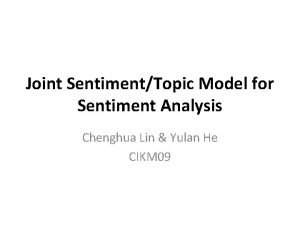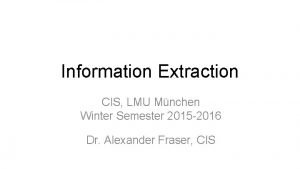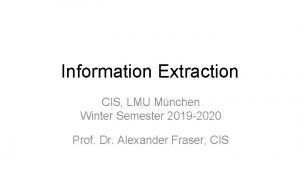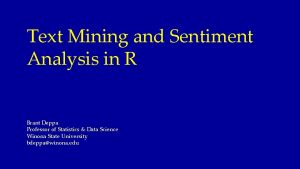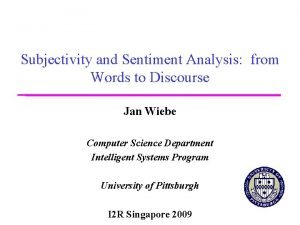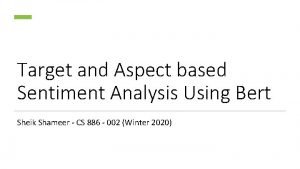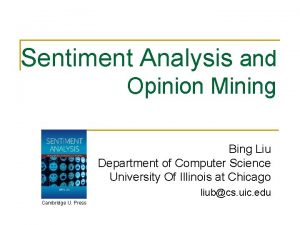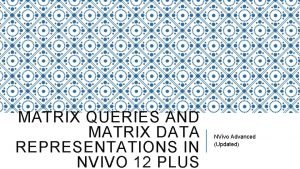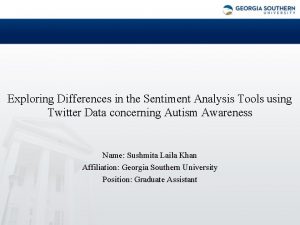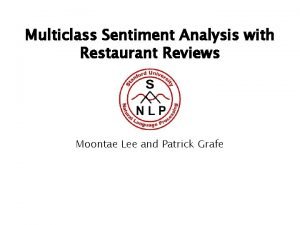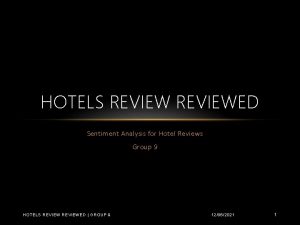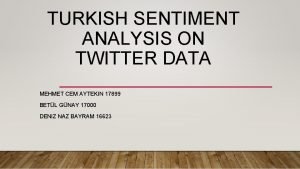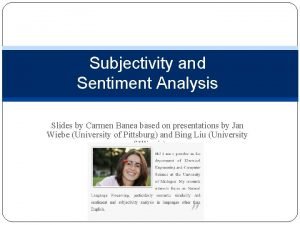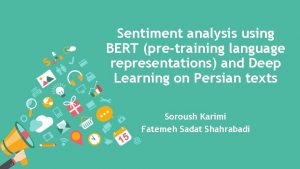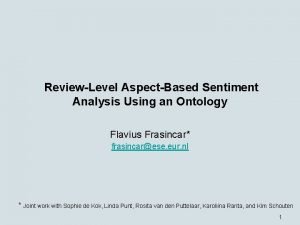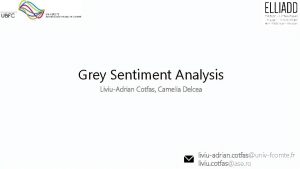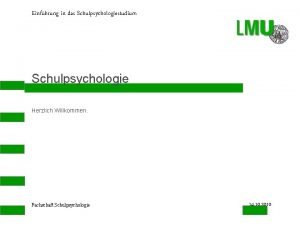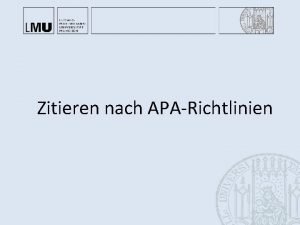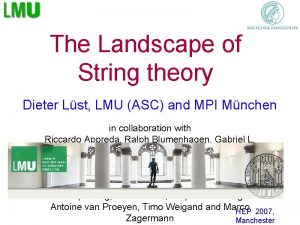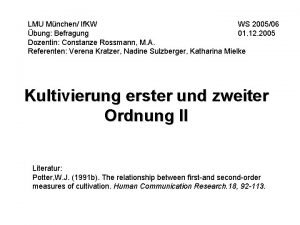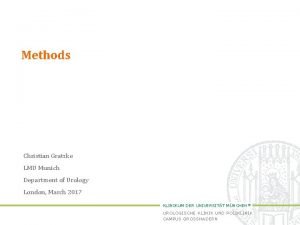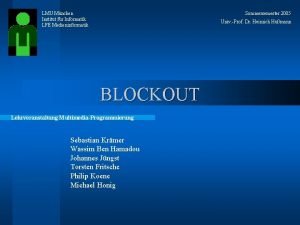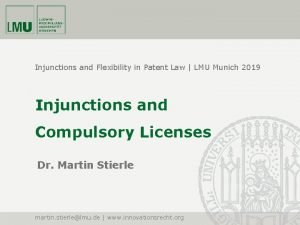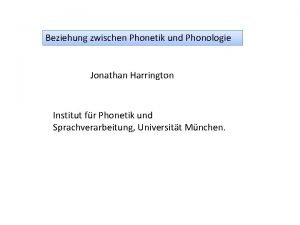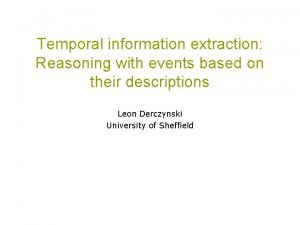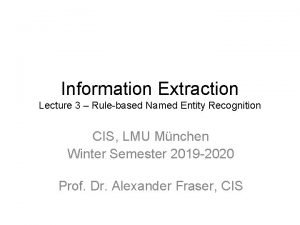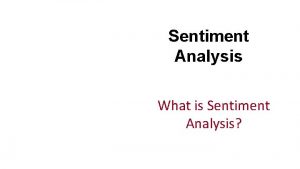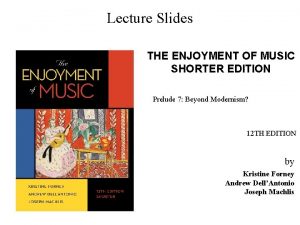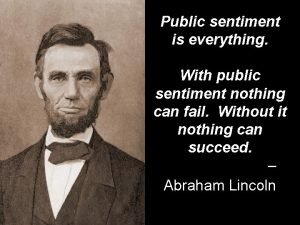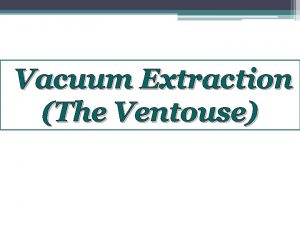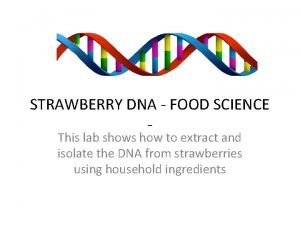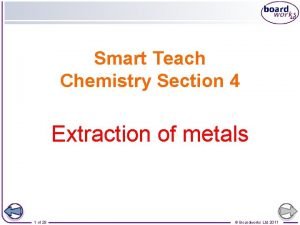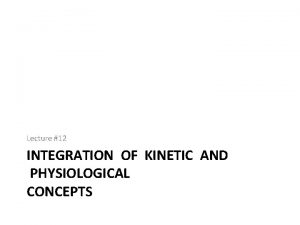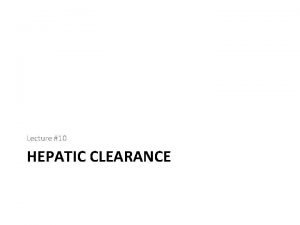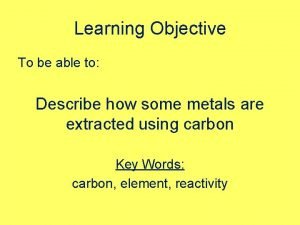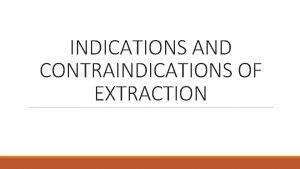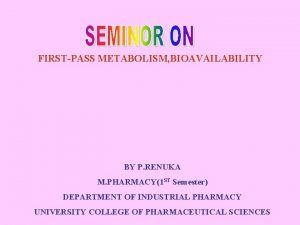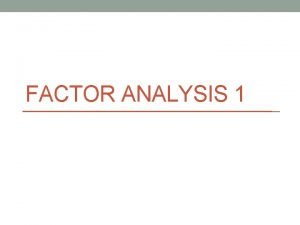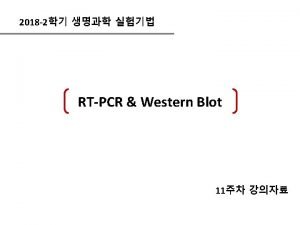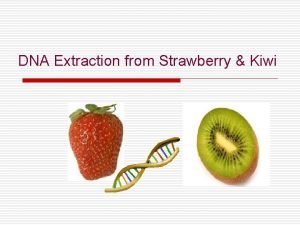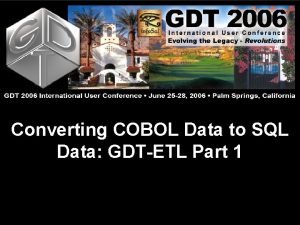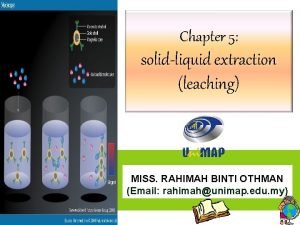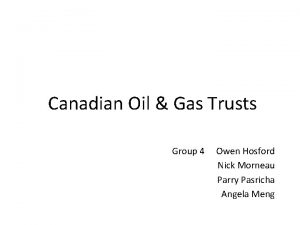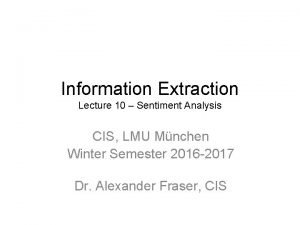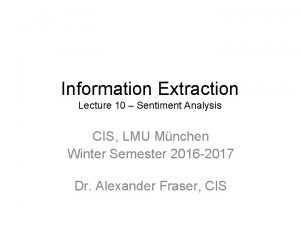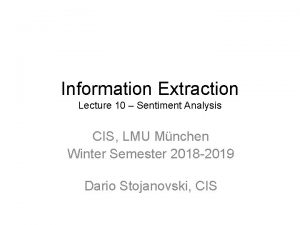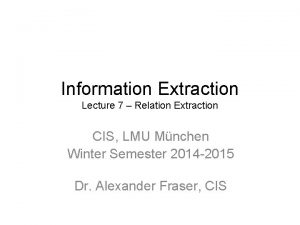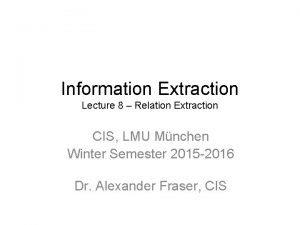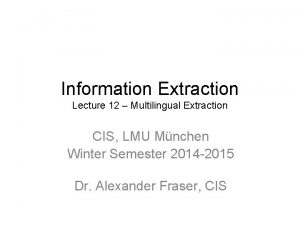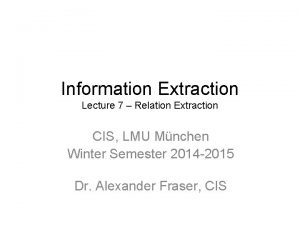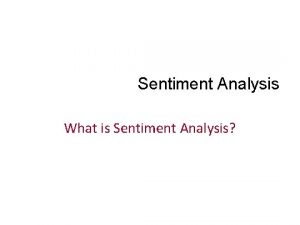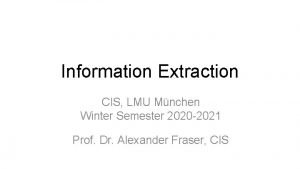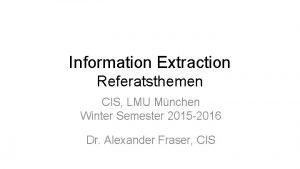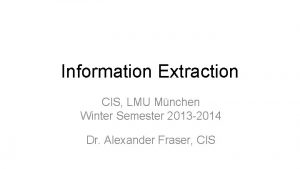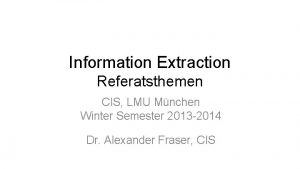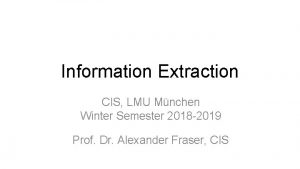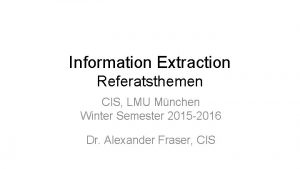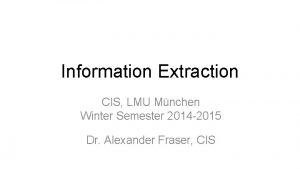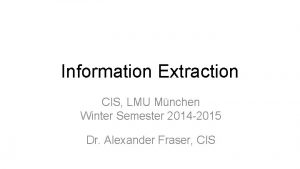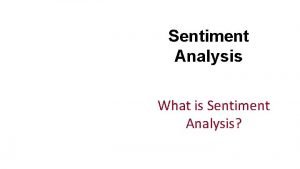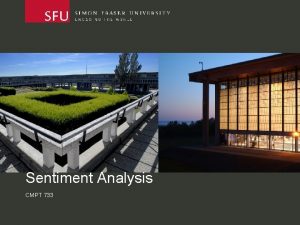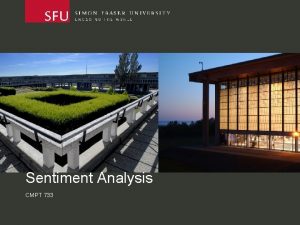Information Extraction Lecture 9 Sentiment Analysis CIS LMU





















































































- Slides: 85

Information Extraction Lecture 9 – Sentiment Analysis CIS, LMU München Winter Semester 2017 -2018 Dario Stojanovski, CIS

Today • Today we will take a tangent and look at another problem in information extraction: sentiment analysis 2

Sentiment Analysis • Determine if a sentence/document expresses positive/negative/neutral sentiment towards some object Slide from Koppel/Wilson

Some Applications • • Review classification: Is a review positive or negative toward the movie? Product review mining: What features of the Think. Pad T 43 do customers like/dislike? Tracking sentiments toward topics over time: Is anger ratcheting up or cooling down? Prediction (election outcomes, market trends): Will Romney or Obama win? Slide from Koppel/Wilson

Social media • Twitter most popular • Short (140 characters) and very informal text • Abbreviations, slang, spelling mistakes • 500 million tweets per day • Tons of applications

Level of Analysis We can inquire about sentiment at various linguistic levels: • • Words – objective, positive, negative, neutral Clauses – “going out of my mind” Sentences – possibly multiple sentiments Documents Slide from Koppel/Wilson

Words • Adjectives – objective: red, metallic – positive: honest important mature large patient – negative: harmful hypocritical inefficient – subjective (but not positive or negative): curious, peculiar, odd, likely, probable Slide from Koppel/Wilson

Words – Verbs • positive: praise, love • negative: blame, criticize • subjective: predict – Nouns • positive: pleasure, enjoyment • negative: pain, criticism • subjective: prediction, feeling Slide from Koppel/Wilson

Clauses • Might flip word sentiment – “not good at all” – “not all good” • Might express sentiment not in any word – “convinced my watch had stopped” – “got up and walked out” Slide from Koppel/Wilson

Sentences/Documents • Might express multiple sentiments – “The acting was great but the story was a bore” • Problem even more severe at document level Slide from Koppel/Wilson

Two Approaches to Classifying Documents • Bottom-Up – Assign sentiment to words – Derive clause sentiment from word sentiment – Derive document sentiment from clause sentiment • Top-Down – Get labeled documents – Use text categorization methods to learn models – Derive word/clause sentiment from models Slide modified from Koppel/Wilson

Some Special Issues • Whose opinion? (Writer) (writer, Xirao-Nima, US) (writer, Xirao-Nima) “The US fears a spill-over’’, said Xirao-Nima, a professor of foreign affairs at the Central University for Nationalities. Slide from Koppel/Wilson

Some Special Issues • Whose opinion? • Opinion about what? Slide from Koppel/Wilson

Laptop Review • I should say that I am a normal user and this laptop satisfied all my expectations, the screen size is perfect, its very light, powerful, bright, lighter, elegant, delicate. . . But the only think that I regret is the Battery life, barely 2 hours. . . some times less. . . it is too short. . . this laptop for a flight trip is not good companion. . . Even the short battery life I can say that I am very happy with my Laptop VAIO and I consider that I did the best decision. I am sure that I did the best decision buying the SONY VAIO Slide from Koppel/Wilson

Advanced • Sentiment towards a specific entity – Person, product, company • Identify expressed sentiment towards several aspects of the text – Different features of a laptop • Emotion Analysis – Identify emotions in text (love, joy, anger, sadness …)

Word Sentiment Let’s try something simple • • Choose a few seeds with known sentiment Mark synonyms of good seeds: good Mark synonyms of bad seeds: bad Iterate Slide from Koppel/Wilson

Word Sentiment Let’s try something simple • • Choose a few seeds with known sentiment Mark synonyms of good seeds: good Mark synonyms of bad seeds: bad Iterate Not quite. exceptional -> unusual -> weird Slide from Koppel/Wilson

Better Idea Hatzivassiloglou & Mc. Keown 1997 1. Build training set: label all adj. with frequency > 20; test agreement with human annotators 2. Extract all conjoined adjectives nice and comfortable nice and scenic Slide from Koppel/Wilson

Hatzivassiloglou & Mc. Keown 1997 3. A supervised learning algorithm builds a graph of adjectives linked by the same or different semantic orientation scenic nice painful handsome terrible fun expensive comfortable Slide from Koppel/Wilson

Hatzivassiloglou & Mc. Keown 1997 4. A clustering algorithm partitions the adjectives into two subsets + slow scenic nice terrible handsome painful fun expensive comfortable Slide from Koppel/Wilson

Even Better Idea Turney 2001 • Pointwise Mutual Information (Church and Hanks, 1989): Slide from Koppel/Wilson

Even Better Idea Turney 2001 • Pointwise Mutual Information (Church and Hanks, 1989): • Semantic Orientation: Slide from Koppel/Wilson

Even Better Idea Turney 2001 • Pointwise Mutual Information (Church and Hanks, 1989): • Semantic Orientation: • PMI-IR estimates PMI by issuing queries to a search engine Slide from Koppel/Wilson

Resources These -- and related -- methods have been used to generate sentiment dictionaries • Sentinet • General Enquirer • … Slide from Koppel/Wilson

Bottom-Up: Words to Clauses • Assume we know the “polarity” of a word • Does its context flip its polarity? Slide from Koppel/Wilson

Prior Polarity versus Contextual Polarity Wilson et al 2005 • Prior polarity: out of context, positive or negative beautiful positive horrid negative • A word may appear in a phrase that expresses a different polarity in context “Cheers to Timothy Whitfield for the wonderfully horrid visuals. ” Contextual polarity Slide from Koppel/Wilson

Example Philip Clap, President of the National Environment Trust, sums up well the general thrust of the reaction of environmental movements: there is no reason at all to believe that the polluters are suddenly going to become reasonable. Slide from Koppel/Wilson

Example Philip Clap, President of the National Environment Trust, sums up well the general thrust of the reaction of environmental movements: there is no reason at all to believe that the polluters are suddenly going to become reasonable. Slide from Koppel/Wilson

Example Philip Clap, President of the National Environment Trust, sums up well the general thrust of the reaction of environmental movements: there is no reason at all to believe that the polluters are suddenly going to become reasonable. prior polarity Contextual polarity Slide from Koppel/Wilson

Lexicon Corpus • • • All Instances Step 1 Neutral or Polar? Word token Word prior polarity Negated subject Modifies polarity Modified by polarity Conjunction polarity General polarity shifter Negative polarity shifter Positive polarity shifter Step 2 Polar Instances Contextual Polarity? Slide from Koppel/Wilson

Lexicon Corpus All Instances Step 1 Neutral or Polar? • Word token • Word prior polarity • • Negated subject Modifies polarity Modified by polarity Conjunction polarity General polarity shifter Negative polarity shifter Positive polarity shifter Step 2 Polar Instances Contextual Polarity? Word token terrifies Word prior polarity negative Slide from Koppel/Wilson

Lexicon Corpus All Instances • Word token • Word prior polarity • Negated subject • • • Step 1 Neutral or Polar? Step 2 Polar Instances Contextual Polarity? Binary features: • Negated For example: – not good – does not look very good v not only good but amazing Modifies polarity Modified by polarity Conjunction polarity • Negated subject General polarity shifter No politically prudent Israeli Negative polarity shifter could support either of them. Positive polarity shifter Slide from Koppel/Wilson

Lexicon Corpus • • All Instances Step 1 Neutral or Polar? Word token Word prior polarity Negated subject • Modifies polarity • Modified by polarity • • Conjunction polarity General polarity shifter Negative polarity shifter Positive polarity shifter Step 2 Polar Instances Contextual Polarity? • Modifies polarity 5 values: positive, negative, neutral, both, not mod substantial: negative • Modified by polarity 5 values: positive, negative, neutral, both, not mod challenge: positive substantial (pos) challenge (neg) Slide from Koppel/Wilson

Lexicon Corpus • • • All Instances Step 1 Neutral or Polar? Word token Word prior polarity Negated subject Modifies polarity Modified by polarity • Conjunction polarity Step 2 Polar Instances Contextual Polarity? • Conjunction polarity 5 values: positive, negative, neutral, both, not mod good: negative good (pos) and evil (neg) • General polarity shifter • Negative polarity shifter • Positive polarity shifter Slide from Koppel/Wilson

Lexicon Corpus • • All Instances Word token Word prior polarity Negated subject Modifies polarity Modified by polarity Conjunction polarity Step 1 Neutral or Polar? Step 2 Polar Instances Contextual Polarity? • General polarity shifter pose little threat contains little truth • Negative polarity shifter • General polarity lack of understanding shifter • Negative polarity • Positive polarity shifter abate the damage

Lexicon Corpus Step 1 All Instances Neutral or Polar? Step 2 Polar Instances Contextual Polarity? Results 2 a Slide from Koppel/Wilson

Lexicon Corpus Step 1 All Instances Neutral or Polar? Step 2 Polar Instances Contextual Polarity? Results 2 b Slide from Koppel/Wilson

Top-Down Sentiment Analysis • So far we’ve seen attempts to determine document sentiment from word/clause sentiment • Now we’ll look at the old-fashioned supervised method: get labeled documents and learn models Slide from Koppel/Pang/Gamon

Finding Labeled Data • Online reviews accompanied by star ratings provide a ready source of labeled data – movie reviews – book reviews – product reviews Slide from Koppel/Pang/Gamon

Movie Reviews (Pang, Lee and V. 2002) • Source: Internet Movie Database (IMDb) • 4 or 5 stars = positive; 1 or 2 stars = negative – 700 negative reviews – 700 positive reviews Slide from Koppel/Pang/Gamon

Evaluation • Initial feature set: – 16, 165 unigrams appearing at least 4 times in the 1400 document corpus – 16, 165 most often occurring bigrams in the same data – Negated unigrams (when "not" appears to the left of a word) • Test method: 3 -fold cross-validation (so about 933 training examples) Slide from Koppel/Pang/Gamon

Results Slide from Koppel/Pang/Gamon

Observations • • In most cases, SVM slightly better than NB Binary features good enough Drastic feature filtering doesn’t hurt much Bigrams don’t help (others have found them useful) • POS tagging doesn’t help • Benchmark for future work: 80%+ Slide from Koppel/Pang/Gamon

Looking at Useful Features • Many top features are unsurprising (e. g. boring) • Some are very unexpected – tv is a negative word – flaws is a positive word • That’s why bottom-up methods are fighting an uphill battle Slide from Koppel/Pang/Gamon

Other Genres • The same method has been used in a variety of genres • Results are better than using bottom-up methods • Using a model learned on one genre for another genre does not work well

Cheating (Ignoring Neutrals) • One nasty trick that researchers use is to ignore neutral data (e. g. movies with three stars) • Models learned this way won’t work in the real world where many documents are neutral • The optimistic view is that neutral documents will lie near the negative/positive boundary in a learned model. Slide modified from Koppel/Pang/Gamon

A Perfect World Slide from Koppel/Pang/Gamon

A Perfect World

The Real World Slide from Koppel/Pang/Gamon

Some Obvious Tricks • Learn separate models for each category or • Use regression to score documents But maybe with some ingenuity we can do even better. Slide from Koppel/Pang/Gamon

Corpus We have a corpus of 1974 reviews of TV shows, manually labeled as positive, negative or neutral Note: neutrals means either no sentiment (most) or mixed (just a few) For the time being, let’s do what most people do and ignore the neutrals (both for training and for testing). Slide from Koppel/Pang/Gamon

Basic Learning • Feature set: 500 highest infogain unigrams • Learning algorithm: SMO • 5 -fold CV Results: 67. 3% correctly classed as positive/negative OK, but bear in mind that this model won’t class any neutral test documents as neutral – that’s not one of its options. Slide from Koppel/Pang/Gamon

So Far We Have Seen. . … that you need neutral training examples to classify neutral test examples In fact, it turns out that neutral training examples are useful even when you know that all your test examples are positive or negative (not neutral). Slide from Koppel/Pang/Gamon

Multiclass Results OK, so let’s consider the three class (positive, negative, neutral) sentiment classification problem. On the same corpus as above (but this time not ignoring neutral examples in training and testing), we obtain accuracy (5 -fold CV) of: • 56. 4% using multi-class SVM • 69. 0% using linear regression Slide from Koppel/Pang/Gamon

Can We Do Better? But actually we can do much better by combining pairwise (pos/neg, pos/neut, neg/neut) classifiers in clever ways. When we do this, we discover that pos/neg is the least useful of these classifiers (even when all test examples are known to not be neutral). Let’s go to the videotape… Slide from Koppel/Pang/Gamon

Optimal Stack Slide from Koppel/Pang/Gamon

Optimal Stack Here’s the best way to combine pairwise classifiers for the 3 -class problem: • IF positive > neutral > negative THEN class is positive • IF negative > neutral > positive THEN class is negative • ELSE class is neutral Using this rule, we get accuracy of 74. 9% (OK, so we cheated a bit by using test data to find the best rule. If, we hold out some training data to find the best rule, we get accuracy of 74. 1%) Slide from Koppel/Pang/Gamon

Key Point Best method does not use the positive/negative model at all – only the positive/neutral and negative/neutral models. This suggests that we might even be better off learning to distinguish positives from negatives by comparing each to neutrals rather than by comparing each to each other. Slide from Koppel/Pang/Gamon

Positive /Negative models So now let’s address our original question. Suppose I know that all test examples are not neutral. Am I still better off using neutral training examples? Yes. Above we saw that using (equally distributed) positive and negative training examples, we got 67. 3% Using our optimal stack method with (equally distributed) positive, negative and neutral training examples we get 74. 3% (The total number of training examples is equal in each case. ) Slide from Koppel/Pang/Gamon

Can Sentiment Analysis Make Me Rich? Slide from Koppel/Pang/Gamon

Can Sentiment Analysis Make Me Rich? NEWSWIRE 4: 08 PM 10/12/04 STARBUCKS SAYS CEO ORIN SMITH TO RETIRE IN MARCH 2005 • How will this messages affect Starbucks stock prices? Slide from Koppel/Pang/Gamon

Impact of Story on Stock Price n n n Are price moves such as these predictable? What are the critical text features? What is the relevant time scale? Slide from Koppel/Pang/Gamon

General Idea • Gather news stories • Gather historical stock prices • Match stories about company X with price movements of stock X • Learn which story features have positive/negative impact on stock price Slide from Koppel/Pang/Gamon

Experiment • MSN corpus • 5000 headlines for 500 leading stocks September 2004 – March 2005. • Price data • Stock prices in 5 minute intervals Slide from Koppel/Pang/Gamon

Feature set • Word unigrams and bigrams. • 800 features with highest infogain • Binary vector Slide from Koppel/Pang/Gamon

Defining a headline as positive/negative • • • If stock price rises more than during interval T, message classified as positive. If stock price declines more than during interval T, message is classified as negative. Otherwise it is classified as neutral. With larger delta, the number of positive and negative messages is smaller but classification is more robust. Slide from Koppel/Pang/Gamon

Trading Strategy n n n Assume we buy a stock upon appearance of “positive” news story about company. Assume we short a stock upon appearance of “negative” news story about company. We exit when stock price moves in either direction or after 40 minutes, whatever comes first. Slide from Koppel/Pang/Gamon

Do we earn a profit? Slide from Koppel/Pang/Gamon

Do we earn a profit? • If this worked, I’d be driving a red convertible. (I’m not. ) Slide from Koppel/Pang/Gamon

Predicting the Future • If you are interested in this problem in general, take a look at: Nate Silver The Signal and the Noise: Why So Many Predictions Fail - but Some Don't 2012 (Penguin Publishers)

Machine learning • Hand crafted features – In addition to unigrams: number of uppercase words, number of exclamation marks, number of positive and negative words … • In social media domain: – emoticons, hashtags (#happy), elongated words (haaaapy)

Deep learning • Automatic feature extraction – Learn feature representation jointly • Little to no preprocessing required • General approaches: – Recursive Neural Networks – Convolutional Neural Networks – Recurrent Neural Networks

Recursive Neural Networks

Recursive Neural Networks

Convolutional Neural Networks • Each row represents a word given by a word embedding with dimensionality d • For a 10 word sentence, our “image” is a matrix of 10 xd

Convolutional Neural Networks Kim (2014).

Feedforward Neural Networks • Feedforward Neural Network with: – Bag of words – Averaged embeddings • Feedforward Neural Network Language Model

Recurrent Neural Networks https: //towardsdatascience. com/sentiment-analysis-using-rnns-lstm-60871 fa 6 aeba

Word embeddings • Word embeddings capture syntactic and semantic regularities – no sentiment information encoded • Good and bad are neighboring words Jeffrey Pennington, Richard Socher, and Christopher D. Manning. 2014. Glo. Ve: Global Vectors for Word Representation

Word embeddings • Update word embeddings by back-propagation • Most similar words before and after training Kim (2014)

Sentiment Analysis in Keras • Keras is a high-level neural networks API • written in Python model = Sequential() model. add(Embedding(vocab_size, emb_dim)) model. add(LSTM(lstm_dim)) model. add(Dense(3, activation=“softmax”))

Sentiment neuron • Character-level language model trained on Amazon reviews • Linear model on this representation achieves state-of-the-art on Stanford Sentiment Treebank using 30 -100 x fewer labeled examples • Representation contains a distinct “sentiment neuron” which contains almost all of the sentiment signal Radford et al. (2017).

Sentiment - Other Issues • Somehow exploit NLP to improve accuracy • Identify which specific product features sentiment refers to (fine-grained) • “Transfer” sentiment classifiers from one domain to another (domain adaptation) • Summarize individual reviews and also collections of reviews Slide modified from Koppel/Pang/Gamon

• Slide sources – Nearly all of the slides today are from Prof. Moshe Koppel (Bar-Ilan University) • Further reading on traditional sentiment approaches – 2011 AAAI tutorial on sentiment analysis from Bing Liu (quite technical) • Deep learning for sentiment – See Stanford Deep Learning Sentiment Demo page – Kim, Yoon. "Convolutional neural networks for sentence classification. " ar. Xiv preprint ar. Xiv: 1408. 5882 (2014). – Socher, Perelygin, Wu, Chuang, Manning, Ng, Potts. Recursive Deep Models for Semantic Compositionality Over a Sentiment Treebank. EMNLP 2013. – Radford, Alec, Rafal Jozefowicz, and Ilya Sutskever. "Learning to generate reviews and discovering sentiment. " ar. Xiv preprint ar. Xiv: 1704. 01444 (2017). 86

• Thank you for your attention! 87
 Joint sentiment topic model for sentiment analysis
Joint sentiment topic model for sentiment analysis Lmu cis
Lmu cis Cis lmu
Cis lmu Information retrieval lmu
Information retrieval lmu Apache spark sentiment analysis
Apache spark sentiment analysis W62vr
W62vr Subjectivity in sentiment analysis
Subjectivity in sentiment analysis Aspect based sentiment analysis using bert
Aspect based sentiment analysis using bert Opinion definition
Opinion definition What is nvivo used for
What is nvivo used for Sentiment analysis tools comparison
Sentiment analysis tools comparison Moontae lee
Moontae lee Sentiment analysis for hotel reviews
Sentiment analysis for hotel reviews Turkish sentiment analysis
Turkish sentiment analysis Turkish sentiment analysis
Turkish sentiment analysis Azure twitter sentiment analysis
Azure twitter sentiment analysis What is subjectivity in sentiment analysis
What is subjectivity in sentiment analysis Bert confusion matrix
Bert confusion matrix Sentiment analysis conclusion
Sentiment analysis conclusion Sentiment analysis
Sentiment analysis 01:640:244 lecture notes - lecture 15: plat, idah, farad
01:640:244 lecture notes - lecture 15: plat, idah, farad Pj bescheinigung lmu
Pj bescheinigung lmu Kontaktstelle mathematik lmu
Kontaktstelle mathematik lmu Judith huber lmu
Judith huber lmu Fachschaft geographie lmu
Fachschaft geographie lmu Fachschaft schulpsychologie lmu
Fachschaft schulpsychologie lmu Zitiert nach
Zitiert nach Lmu lst
Lmu lst Lmu otd
Lmu otd Constanze rossmann lmu
Constanze rossmann lmu Videoonline lmu allgemeine pädagogik
Videoonline lmu allgemeine pädagogik Grid and cloud computing lmu
Grid and cloud computing lmu Lmu
Lmu Lmu medieninformatik
Lmu medieninformatik Lmu munich law
Lmu munich law Pags lmu
Pags lmu Pags lmu
Pags lmu Phonetik lmu
Phonetik lmu Algorithmen und datenstrukturen lmu
Algorithmen und datenstrukturen lmu Temporal information extraction
Temporal information extraction Ner relation extraction
Ner relation extraction Information extraction algorithms
Information extraction algorithms Clinical information system cis
Clinical information system cis Twitter sentiment
Twitter sentiment Chapter 68 underscoring meaning
Chapter 68 underscoring meaning Public sentiment is everything
Public sentiment is everything Abolitionist sentiment grows
Abolitionist sentiment grows Healthmis.ng
Healthmis.ng Exploratory data analysis lecture notes
Exploratory data analysis lecture notes Sensitivity analysis lecture notes
Sensitivity analysis lecture notes Factor analysis lecture notes
Factor analysis lecture notes Analysis of algorithms lecture notes
Analysis of algorithms lecture notes Quadrant streak
Quadrant streak Power system analysis lecture notes
Power system analysis lecture notes Ventouse extraction
Ventouse extraction Exodontia definition
Exodontia definition Linear pharmacokinetics
Linear pharmacokinetics Thar sfe
Thar sfe Strawberry dna extraction materials
Strawberry dna extraction materials Physical properties of metals
Physical properties of metals Cd4 extraction
Cd4 extraction Practical extraction and report language
Practical extraction and report language Partial breech extraction delivery
Partial breech extraction delivery Water extraction montarra
Water extraction montarra Microwave assisted extraction
Microwave assisted extraction Hepatic extraction ratio
Hepatic extraction ratio Venule
Venule Extraction of metals
Extraction of metals Comment extraire la chlorophylle brute
Comment extraire la chlorophylle brute Individualize the dose
Individualize the dose Contraindications of extraction
Contraindications of extraction Contraindication of tooth extraction
Contraindication of tooth extraction Extraction and galenicals
Extraction and galenicals First pass metabolism definition pharmacology
First pass metabolism definition pharmacology Kmo test interpretation
Kmo test interpretation Penicillin extraction
Penicillin extraction Wedge principle in exodontia
Wedge principle in exodontia Easy blue 원리
Easy blue 원리 Purpose of extraction
Purpose of extraction O2 extraction ratio
O2 extraction ratio Cobol data extraction
Cobol data extraction Hepatic extraction ratio formula
Hepatic extraction ratio formula Triangular diagram for liquid-liquid extraction
Triangular diagram for liquid-liquid extraction Moving bed leaching equipment
Moving bed leaching equipment Canadian oil and gas trusts
Canadian oil and gas trusts Spouted bed extraction
Spouted bed extraction
